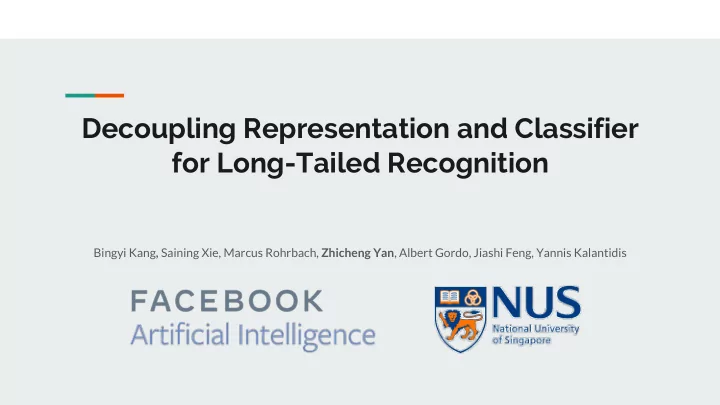

Decoupling Representation and Classifier for Long-Tailed Recognition Bingyi Kang , Saining Xie, Marcus Rohrbach, Zhicheng Yan , Albert Gordo, Jiashi Feng, Yannis Kalantidis
Long-tailed classification Problem statement ❏ Training set: long-tailed distribution ❏ Head v.s. Tail ❏ Testing set: balanced distribution ❏ Evaluation: three splits based on cardinality Existing methods ❏ Rebalancing the data Up/Down sampling tail/head classes. ❏ Rebalancing the loss Assign larger/smaller weight to tail/head classes. e.g., CB-Focal[1], LDAM[2] [1] Cui, Yin, et al. "Class-balanced loss based on effective number of samples." CVPR. 2019. [2] Cao, Kaidi, et al. "Learning imbalanced datasets with label-distribution-aware margin loss." NIPS. 2019.
The problem behind long-tail Classification performance Representation Quality Classifier Quality Performance Final
The problem behind long-tail Classification performance Representation Quality Classifier Quality Quality
The problem behind long-tail Classification performance Representation Quality Classifier Quality Quality NOTE: Such observations are drawn empirically!
Notations ● Feature representation: 𝑔 𝑦; 𝜾 = 𝑨 ● Linear classifiers: 𝑗 𝑨 = 𝑋𝑗 𝑈 𝑨 + 𝑐 ● Final prediction: , 𝑧 = 𝑏𝑠𝑛𝑏𝑦 𝑗(𝑨)
What is the problem with the classifier? ImageNet_LT ResNext50 Jointly learned classifier Small weight scale; Dataset distribution Small confidence score; Poor performance. After joint training with instance-balanced sampling, ● the norms of the weights are correlated with the size of the classes .
How to improve the classifier? -- Three ways I. Classifier Retraining (cRT) KEY: break the norm v.s. class size correlation. ❏ Freeze the representation. ❏ Retrain the linear classifier with class- balanced sampling.
How to improve the classifier? -- Three ways KEY: break the norm v.s. #data I. Classifier Retraining (cRT) correlation. ❏ Freeze the representation. ❏ Retrain the linear classifier with class- balanced sampilng. II. Tau-Normalization ( 𝞾 -Norm) ❏ Adjust the classifier weight norms directly ❏ Tau is “temperature” of the normalization.
How to improve the classifier? -- Three ways KEY: break the norm v.s. #data I. Classifier Retraining (cRT) correlation. ❏ Freeze the representation. ❏ Retrain the linear classifier with class-balanced sampling II. Tau-Normalization ( 𝞾 -Norm) ❏ Adjust the classifier weight norms directly. ❏ Tau is “temperature” of the normalization. III. Learnable Weight Scaling (LWS) ❏ Tune the scale of each weight vector through learning
Classifier Rebalancing - Without classifier rebalancing (i.e. Joint training), progressively-balanced sampling works best - When instance-balanced sampling is used and classifiers are re-balanced, medium-shot, and few- shot performance increases significantly, and achieve best results
How Does Classifier Rebalancing Work? Larger weights ==> Wider classification cone ● Un-normalized weights ==> Unbalanced decision boundaries ● Classifier rebalancing ==> More balanced decision boundaries ●
Can we finetune both trunk and classifier? The best performance is achieved when only classifier is retrained, and ● backbone model is fixed.
Experiments Datasets I. ImageNet_LT ❏ Constructed from ImageNet 2012 ❏ 1000 categories, 115.8k images II. iNaturalist 2018 ❏ Contains only species. ❏ 8142 categories, 437.5k images III. Places_LT ❏ Constructed from Places365 ❏ 365 classes
Experiments ➢ Datasets From joint to LWS/cRT/tau-norm, with little sacrifice on many shot I. ImageNet_LT ➢ New SOTA can be achieved ❏ Constructed from ImageNet 2012 ➢ Improvement on Medium: ~10, few: 20+ ❏ 1000 categories, 115.8k images
Experiments Datasets ➢ From joint to cRT/tau-norm, little sacrifice on head classes, Large gain on tail classes. II. iNaturalist 2018 ➢ Once representation is sufficiently trained, ❏ Contains only species. New SOTA can be easily obtained. ❏ 8142 categories, 437.5k images ➢ With little sacrifice on many shot, new SOTA can be achieved. * Notation: 90 epochs/200 epochs
Take home messages ❏ For solving long-tailed recognition Code is available! problem, representation and classifiers should be considered separately. ❏ Our methods achieve performance gain by finding a better tradeoff (currently the best one) between head and tail classes. ❏ Future research might be focusing more on improving representation quality. https://github.com/facebookresearch/classifier-balancing
Recommend
More recommend